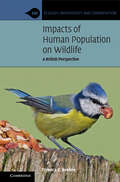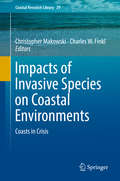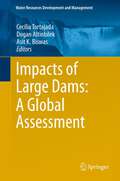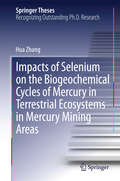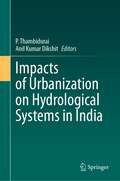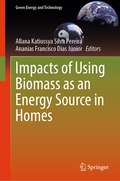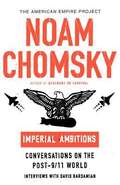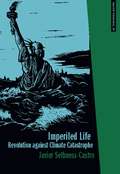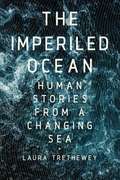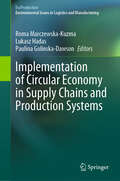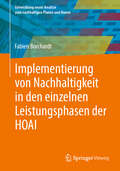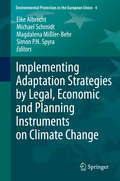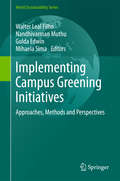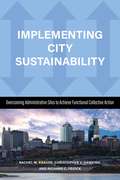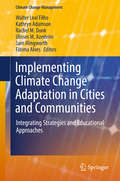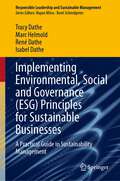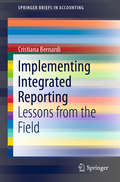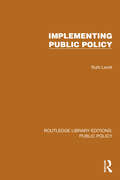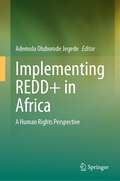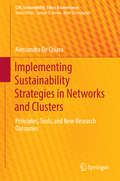- Table View
- List View
Impacts of Human Population on Wildlife: A British Perspective (Ecology, Biodiversity and Conservation)
by Trevor J. BeebeeWildlife and the countryside are highly valued by people in the UK, and for good reason. Healthy habitats are invaluable assets and promote human wellbeing. However, they are under increasing threat from, among other things, relentless urban expansion and intensive modern agriculture. These pressures largely stem from a major underlying cause – the high and growing population of humans living in the UK. This book provides an overview of wildlife in the UK and its recent status; factors contributing to wildlife declines; trends in human numbers; international deliberations about the impacts of human population growth; and the implications for the future of wildlife conservation in the UK. The evidence-based text includes comparisons of wildlife declines and their causes in other countries, providing a global perspective. This book is for ecologists, naturalists and conservation biologists studying and working in academia or in consultancies, as well as all those interested in wildlife conservation.
Impacts of Invasive Species on Coastal Environments: Coasts in Crisis (Coastal Research Library #29)
by Charles W. Finkl Christopher MakowskiThis book focuses on the global threats to coastal environments from invasive, non-native species and examines how these alien biological species adversely alter landscapes and socioeconomic conditions as well as the psychological attitudes and perceptions of local inhabitants and tourists. Designed for the professional or specialist in marine science, coastal zone management, biology, and related disciplines, this volume appeals to those not only working directly with invasive flora and fauna species, but also those individuals involved in a wide array of coastal related fields. Examples and case studies of coastal invasive species are drawn from many different geographic areas worldwide, including North and South America, Europe, Oceania, the Caribbean, Southeast Asia, and Africa.
Impacts of Large Dams: A Global Assessment
by Asit K. Biswas Cecilia Tortajada Dogan AltinbilekOne of the most controversial issues of the water sector in recent years has been the impacts of large dams. Proponents have claimed that such structures are essential to meet the increasing water demands of the world and that their overall societal benefits far outweight the costs. In contrast, the opponents claim that social and environmental costs of large dams far exceed their benefits, and that the era of construction of large dams is over. A major reason as to why there is no consensus on the overall benefits of large dams is because objective, authoritative and comprehensive evaluations of their impacts, especially ten or more years after their construction, are conspicuous by their absence. This book debates impartially, comprehensively and objectively, the positive and negative impacts of large dams based on facts, figures and authoritative analyses. These in-depth case studies are expected to promote a healthy and balanced debate on the needs, impacts and relevance of large dams, with case studies from Africa, Asia, Australia, Europe and Latin America.
Impacts of Selenium on the Biogeochemical Cycles of Mercury in Terrestrial Ecosystems in Mercury Mining Areas
by Hua ZhangFrom a new perspective, namely focusing on the interaction of selenium and mercury, this thesis provides new insights into traditional research on biogeochemical cycles of mercury in soil-plant interaction and associated human exposure and risks. The subject of this thesis is both valuable and timely, providing essential information not only on selenium-mercury interaction in the soil-plant system but also on how to assess the combined benefits and risk of co-exposure to mercury and selenium. This work also sheds light on future aspects regarding prevention, remediation and risk management for environmental mercury contamination. Presenting high-quality papers published in leading international SCI journals such as Environmental Health Perspectives and Environmental Science & Technology and having been recognized with the Special Award of Presidential Scholarship Award and Excellent Doctoral Dissertations Prize of the Chinese Academy of Sciences (CAS), this thesis offers a valuable resource for scientific communities, policy-makers and non-experts who are interested in this field. Dr. Hua Zhang works at the Norwegian Institute for Water Research (NIVA), Oslo, Norway.
Impacts of Urbanization on Hydrological Systems in India
by Anil Kumar Dikshit P. ThambiduraiThis book documents the various impacts of urbanization on hydrological systems and water resources. The first half of the book is focused on urbanization and surface waters, starting with the status of hydrological systems in the urban areas, i.e. the catchment characteristics and changes in rainfall dynamics. The most pronounced hydrological problems in cities are changes in runoff due to precipitation. Recently, rain events have been less frequent but more intense, sometimes leading to flash floods. Though the substantial increase in runoff causes floods in the urbanized area, it may be attributed to the reduction of infiltration due to construction of roads. This, in turn, results in groundwater decline and depletion. The second half of the book covers the impact of urbanization on groundwater, which starts with hindered or significantly reduced recharge taking place due to altered urban surfaces. The limited groundwater resources are over-exploited by the urban population, leading to water scarcity and depletion. Groundwater gets polluted due to solid waste dumping sites or by wastewaters discharged by industries. The book will be useful for researchers, educators, municipal/city authorities, government officials, and NGOs.
Impacts of Using Biomass as an Energy Source in Homes (Green Energy and Technology)
by Allana Katiussya Silva Pereira Ananias Francisco Dias JúniorThe book deepens understanding of biomass sources and technologies used for cooking worldwide. It contributes directly to the creation of policies aimed at the mitigation of climate change.Historically, wood is considered humanity's first source of energy. Even after decades of use and industrialization processes, it is still considered the most important single source of renewable energy. About a third of the world's population is energetically dependent on wood for cooking and/or heating. Recently, the Covid-19 pandemic made it impossible to purchase fuels such as liquefied petroleum gas (LPG), forcing families in financial difficulties to opt for cheaper and more accessible sources of energy, such as wood and vegetable coal. This has been the picture of many families around the world and negatively impacts the environment and energy security. Considering that there are still many wood residues that are wasted and that tropical forests need to be conserved, knowledge about the energy use of wood residues is also essential. This is even more relevant when considering the significant volume of biomass coming from the sustainable management of the largest tropical forest in the world, the Amazon Forest.The book considers which wood variables should be taken into account when thinking about energy generation, how do food cooking technologies contribute to potentiating pollutants emissions, and how can these harmful effects be mitigated. It describes the chemical composition of biomass and the chemical compounds released during its burning, as well as their impacts on the environment and human health. It also presents the influence that technologies used in food cooking have on pollutant emissions and which alternatives can be used, such as the use of solar energy.
Imperfections in Crystalline Solids
by Wei Cai William D. NixThis textbook provides students with a complete working knowledge of the properties of imperfections in crystalline solids. Readers will learn how to apply the fundamental principles of mechanics and thermodynamics to defect properties in materials science, gaining all the knowledge and tools needed to put this into practice in their own research. Beginning with an introduction to defects and a brief review of basic elasticity theory and statistical thermodynamics, the authors go on to guide the reader in a step-by-step way through point, line, and planar defects, with an emphasis on their structural, thermodynamic, and kinetic properties. Numerous end-of-chapter exercises enable students to put their knowledge into practice, and with solutions for instructors and MATLAB programs available online, this is an essential text for advanced undergraduate and introductory graduate courses in crystal defects, as well as being ideal for self-study.
Imperial Ambitions: Conversations on the Post-9/11 World
by Noam Chomsky David Barsamian[From the book cover] Timely, illuminating, and urgently needed, this volume of interviews conducted by award-winning radio journalist David Barsamian features Noam Chomsky discussing U.S. policies in the increasingly unstable post-9/11 world. In these exchanges, appearing for the first time in print, Chomsky offers his frank, provocative, and informed views on the invasion and occupation of Iraq, the doctrine of preemptive strikes against so-called rogue states, and the growing threat to international peace posed by the U.S. drive for domination. In his inimitable style, Chomsky also dissects the propaganda system that fabricates a mythic past and airbrushes inconvenient facts out of history.
Imperial Texas: An Interpretive Essay in Cultural Geography
by D.W. MeinigImperial Texas examines the development of Texas as a human region, from the simple outline of the Spanish colony to the complex patterns of the modern state. In this study in cultural geography set into a historical framework, D. W. Meinig, professor of geography at Syracuse University, discusses the “various peoples of Texas, who they are, where they came from, where they settled, and how they are proportioned one to another from place to place.”
Imperiled Life
by Javier SethnessImperiled Life theorizes an exit from the potentially terminal consequences of capital-induced climate change. It is a collection of reflections on the phenomenon of catastrophe--climatological, political, social--as well as on the possibilities of overcoming disaster. Javier Sethness-Castro presents the grim news from contemporary climatologists while providing a reconstructive vision inspired by anarchist intellectual traditions and promoting critical thought as a means of changing our historical trajectory. Javier Sethness-Castro is a libertarian socialist and a rights advocate. Imperiled Life is his first book.
Imperiled Ocean: Human Stories From A Changing Sea
by Laura TretheweyAn exploration of the earth's last wild frontier, filled with high-stakes stories that explores a vast territory undergoing tremendous change and the people and places facing an uncertain future. On a life raft in the Mediterranean, a teenager from Ghana wonders whether he will reach Europe alive, and if he does, whether he will be allowed to stay. In the North Atlantic, a young chef disappears from a cruise ship, leaving a mystery for his friends and family to solve. A water-squatting community battles eviction from a harbor in a Pacific Northwest town, raising the question of who owns the water. Imperiled Ocean by ocean journalist Laura Trethewey is a deeply reported work of narrative journalism that follows people as they head out to sea. What they discover holds inspiring and dire implications for the life of the ocean — and for all of us back on land. As Imperiled Ocean unfolds, battles are fought, fortunes made, lives lost, and the ocean approaches an uncertain future. Behind this human drama, the ocean is growing ever more unstable, threatening to upend life on land. As we explore with Tretheway, we meet biologist Erin Stoddard tracking sturgeon in the Pacific Northwest. Unable to stop the development and pollution destroying the fish’s habitat, Stoddard races to learn about the fish before it disappears. This prehistoric fish has survived more than 300 million years on earth and could hold important truths about how humanity might make itself amenable to a changing ocean. As a fisher and scientist, Erin’s ability to listen to the water becomes a parable for what faces the ocean today. By eavesdropping on an imperiled world, he shows a way we can move forward to save the oceans we all share—through listening and discovery.
Imperiled Reef: The Fascinating, Fragile Life of a Caribbean Wonder
by Sandy SheehyThe beauty and drama of a world beneath the surface of the waves This book brings alive the richly diverse world of an underwater paradise: the Mesoamerican Barrier Reef. Stretching 625 miles through the Caribbean Sea along the coasts of Mexico, Belize, Guatemala, and Honduras, this reef is the second largest coral structure on the planet. Imperiled Reef searches out the breathtaking intricacies of this endangered ecological treasure. Research shows that the future of the reef is at risk, Sheehy explains. Looking closely at threats ranging from global warming to overfishing to irresponsible development, Sheehy draws attention to the inspiring efforts of nongovernmental agencies, scientists, and local communities who are working together to address these challenges. She includes practical actions individuals can take to protect this reef—as well as marine ecosystems everywhere. Celebrating a vast, submerged landscape that has too often been undervalued, Imperiled Reef is both a strong case for protecting an international marvel and a powerful message of hope for the world’s oceans.
Implementation of Circular Economy in Supply Chains and Production Systems (EcoProduction)
by Paulina Golinska-Dawson Roma Marczewska-Kuzma Lukasz HadasThis book covers various aspects of sustainability, including green economy, green energy, and waste management. It offers analysis of key challenges in contemporary world, as well as concepts and solutions that can be implemented to deal with them. The authors represent various universities located all over the Europe; hence, their perspectives are different and confronting their points of view will result in holistic review of current topics connected with circular economy. The book can be interesting for academics, as it presents the latest research results, for business practitioners, as it supplements research with case studies and real-life examples, and for students, who can learn about new challenges solutions they will have to deal with in their professional careers.
Implementierung von Nachhaltigkeit in den einzelnen Leistungsphasen der HOAI (Entwicklung neuer Ansätze zum nachhaltigen Planen und Bauen)
by Fabien BorchardtDas Buch bietet einen allgemeingültigen Leitfaden zur Implementierung von Nachhaltigkeitsaspekten in den einzelnen Leistungsphasen der HOAI. Dieser Leitfaden bezieht sich auf die Planung, Ausführung, Bewirtschaftung und Verwertung eines Neubaus hinsichtlich öffentlicher Gebäude. Die Inhalte und Beiträge des Leitfadens werden durch eine ausführliche Untersuchung des derzeitigen Standes der Technik und der Forschung angefertigt. Dabei werden die derzeitigen Regelwerke bzw. gültigen Standards, Bewertungs- und Zertifizierungssysteme, aktuelle Forschungsarbeiten sowie existierende Leitfäden begutachtet und für die eigene Arbeit bewertet. Der thematische Schwerpunkt dieser Arbeit liegt auf der anschließenden Entwicklung eines Leitfadens, welcher Nachhaltigkeitskriterien für die unterschiedlichen Stakeholder eines öffentlichen Bauvorhabens sowie deren Leistungsphasen gemäß HOAI festlegt. Die Nachhaltigkeitskriterien orientieren sich an der Optimierung der ökologischen, ökonomischen, soziokulturellen und technischen Qualität sowie an der Prozess- und Standortqualität des zu erstellenden Gebäudes. Neben den Leistungsphasen nach HOAI werden ebenso die „Phase 0“ sowie „Phase 10“ betrachtet. Somit soll eine ganzheitliche lebenszyklusorientierte Betrachtung eines Gebäudes durch den Leitfaden ermöglicht werden. Der Leitfaden stellt die allgemeine Vorgehensweise und Methodik zur Implementierung von Nachhaltigkeitsaspekten in der Planung, Ausführung, Bewirtschaftung und Verwertung eines Neubaus dar. Mit Hilfe der Erstellung des allgemeingültigen Leitfadens für öffentliche Bauvorhaben soll eine Grundlage für die Erstellung eines nachhaltigen Neubaus geschaffen werden. Ein abgeschlossenes Bauvorhaben wird mit dem erstellten Leitfaden evaluiert. Hierbei wird auf die Verbesserungspotentiale zur Implementierung weiterer Nachhaltigkeitsaspekte für zukünftige Bauprojekte öffentlicher Auftraggeber eingegangen.
Implementing Adaptation Strategies by Legal, Economic and Planning Instruments on Climate Change
by Michael Schmidt Eike Albrecht Magdalena Mißler-Behr Simon P. N. SpyraThe causes and effects of climate change are just as varied as the proposed solutions and approaches for dealing with the problem. Given the global character of climate change, comprehensive global cooperation is called for that leads to effective and appropriate international action in accordance with the respective responsibilities. These will inevitably differ depending on the capabilities and the social and economic situations of the respective actors. The contributions in this book present a variety of ideas, approaches and tools regarding the adaptation to climate change in specific countries and regions. In addition to examining (existing) legal instruments, they also focus on the implementation of economic instruments and planning tools, as well as their (further) development. Rather than simply discussing strategies to counteract climate change by reducing emissions, the authors also search for ways of actively adapting to climate change.
Implementing Campus Greening Initiatives
by Walter Leal Filho Nandhivarman Muthu Golda Edwin Mihaela SimaFirmly rooted in the theory and practice of sustainable development, this book offers a comprehensive resource on sustainability, focusing on both industrialized and developing nations. Implementing Campus Greening Initiatives: Approaches, Methods and Perspectives is an attempt to promote and disseminate the work being done in this field by universities around the world. The need to integrate the principles and concepts of green campuses and sustainability into the core of students' educational experiences, from high school to college or university, has now been broadly recognized. By doing so, we can ensure that the students of today and tomorrow will acquire the knowledge, skills, attitudes and values needed to create a more sustainable economy and social environment.
Implementing City Sustainability: Overcoming Administrative Silos to Achieve Functional Collective Action
by Rachel M. Krause Christopher Hawkins Richard C. FelockImplementing City Sustainability examines the structures and processes that city governments employ to pursue environmental, social, and economic well-being within their communities. As American cities adopt sustainability objectives, they are faced with the need to overcome fuzzy-boundary, coordination, and collective action challenges to achieve successful implementation. Sustainability goals often do not fit neatly into traditional city government structures, which tend to be organized around specific functional responsibilities, such as planning, public works, parks and recreation, and community development. The authors advance a theory of Functional Collective Action and apply it to local sustainability to explain how cities can—and in some cases do—organize to successfully administer changes to achieve complex objectives that transcend these organizational separations. Implementing City Sustainability uses a mixed-method research design and original data to provide a national overview of cities’ sustainability arrangements, as well as eight city case studies highlighting different means of organizing to achieve functional collective action. By focusing not just on what cities are doing to further sustainability, but also on how they are doing it, the authors show how administrative structure enables—or inhibits—cities to overcome functional divides and achieve successful outcomes.
Implementing City Sustainability: Overcoming Administrative Silos to Achieve Functional Collective Action
by Rachel M. Krause Christopher Hawkins Richard C. FelockImplementing City Sustainability examines the structures and processes that city governments employ to pursue environmental, social, and economic well-being within their communities. As American cities adopt sustainability objectives, they are faced with the need to overcome fuzzy-boundary, coordination, and collective action challenges to achieve successful implementation. Sustainability goals often do not fit neatly into traditional city government structures, which tend to be organized around specific functional responsibilities, such as planning, public works, parks and recreation, and community development. The authors advance a theory of Functional Collective Action and apply it to local sustainability to explain how cities can—and in some cases do—organize to successfully administer changes to achieve complex objectives that transcend these organizational separations. Implementing City Sustainability uses a mixed-method research design and original data to provide a national overview of cities’ sustainability arrangements, as well as eight city case studies highlighting different means of organizing to achieve functional collective action. By focusing not just on what cities are doing to further sustainability, but also on how they are doing it, the authors show how administrative structure enables—or inhibits—cities to overcome functional divides and achieve successful outcomes.
Implementing Climate And Global Change Research: A Review Of The Final U.s. Climate Change Science Program Strategic Plan
by Committee to Review the U.S. Climate Change Science Program Strategic PlanThe book reviews a draft strategic plan from the U. S. Climate Change Science Program, a program formed in 2002 to coordinate and direct U. S. efforts in climate change and global change research. The U. S. Climate Change Science Program incorporates the decade-old Global Change Research Program and adds a new component--"the Climate Change Research Initiative--"whose primary goal is to measurably improve the integration of scientific knowledge, including measures of uncertainty, into effective decision support systems and resources.
Implementing Climate Change Adaptation in Cities and Communities
by Walter Leal Filho Ulisses M. Azeiteiro Fátima Alves Kathryn Adamson Rachel M. Dunk Sam IllingworthThis book analyzes how climate change adaptation can be implemented at the community, regional and national level. Featuring a variety of case studies, it illustrates strategies, initiatives and projects currently being implemented across the world. In addition to the challenges faced by communities, cities and regions seeking to cope with climate change phenomena like floods, droughts and other extreme events, the respective chapters cover topics such as the adaptive capacities of water management organizations, biodiversity conservation, and indigenous and climate change adaptation strategies. The book will appeal to a broad readership, from scholars to policymakers, interested in developing strategies for effectively addressing the impacts of climate change.
Implementing Environmental, Social and Governance: A Practical Guide in Sustainability Management (Responsible Leadership and Sustainable Management)
by Marc Helmold Tracy Dathe René Dathe Isabel DatheThe concept of environmental, social and governance (ESG) is rapidly emerging as the new global industry standard and an important benchmarking tool for socially responsible investments. Major corporations seek the expertise of specialized consultants to develop and implement tailored ESG framework for their businesses. This book offers a guide to ESG and its practical applications. Beyond introducing the structured procedures of the most common ESG approaches, it delves into the comprehensive impact on the value chain, providing practical insights. The text explores the latest trends in various business sectors, offering insights into their ESG practices. Closing with a forward-looking perspective, the book anticipates future developments such as climate change management and ESG certifications, while also addressing potential pitfalls encapsulated by the term “greenwashing”.Written by authors with a solid background in teaching and research, the book establishes a robust theoretical foundation. The inclusion of numerous practical examples and country-specific recommendations enhances this book’s applicability and makes it an invaluable resource to those navigating the complexities of ESG.
Implementing Integrated Reporting: Lessons from the Field (SpringerBriefs in Accounting)
by Cristiana BernardiSustainability, the environment, corporate accountability, social justice, integration – these are the buzzwords of our century. This book takes readers on a journey through the landscape of standard-setting giants and corporate reporting paradigms through the eyes of two companies that have taken very different paths toward integrated thinking. Both stories provide new insights into the transition to integrated reporting, as envisaged by the International Integrated Reporting Council (IIRC), and how integrated reporting is reshaping our views on transparency. However, the top-down approach adopted in studies of integrated reporting in practice has left many questions unanswered: Is it effective? How does it evolve into established practice? Is it just another management fad? This bottom-up critique answers all these questions and one more: Could integrated reporting become the corporate reporting norm? We shall see.Given its depth of coverage, the book appeals to IIRC academic community, participants in integrated reporting networks, and others interested in integrated reporting.
Implementing Public Policy (Routledge Library Editions: Public Policy)
by Ruth LevittOriginally published in 1980, this book takes as case studies various policies arising from the Control of Pollution Act 1974 and traces their implementation and impact. The information about disposal of toxic waste on land, bathing water quality, noise abatement zones and industrial air pollution offers fruitful areas of investigation, highlighting different aspects of environmental pollution policy and its wider implications as well as illustrating vital components of the implication process, including enforcement and discretion. Many of these issues are as pertinent now as when the book was first published. Drawing on this evidence to establish some of the features central to public policy generally, the book will be of use to historians of public and environmental policy and those teaching and researching it.
Implementing REDD+ in Africa: A Human Rights Perspective
by Ademola Oluborode JegedeThis book presents a cohesive collection of contributions representing an African scholarly voice on some of the most burning and emerging topics and experiences regarding the implementation of REDD+ in Africa from a human rights perspective. It addresses the international human rights obligations of states and non-state actors in the context of REDD+ implementation in Africa; how current practices in various African states reinforce or affect human rights standards; and critical issues concerning the rights of vulnerable groups such as women, Indigenous populations, and forest dwellers in the implementation of REDD+ in Africa. Further, it investigates potential gaps in the existing laws, and how they can be addressed from a comparative point of view. The book also sheds light on the roles that different actors can play in fostering change and identifies best practices in the implementation of REDD+ in Africa.The book offers a rich intellectual resource for various actors in the environmental science, climate and environmental law fields who are often confronted with the challenge of how to manage the delicate balance of forests as a development resource; forests as a climate-change mitigation resource; and forests as a catalyst for the rights of vulnerable populations. The book responds to the imbalance and gaps in REDD+ scholarship. Addressing such lacuna in an edited volume of this nature is essential to the present and future work of practitioners, academics and other actors with a sustained interest in REDD+ in Africa.
Implementing Sustainability Strategies in Networks and Clusters
by Alessandra De ChiaraThis book investigates the dynamics of the management of sustainability in networks and clusters - an area of increasing importance that is neglected by the many studies addressing sustainability at the single-enterprise level. The focus is in particular on projects involving groups of enterprises with a high level of productive interdependence and steady relations that allow sharing of resources and activities. The book is organized into two parts, the first of which discusses the value of the territory for firm competitiveness, examines the importance of social capital in creating sustainable business behaviors and "unique" networks, and describes principles and tools for the implementation and management of sustainability strategies in networks or clusters. The second part then presents the methodology and outcomes of empirical research conducted on industrial districts and productive centres in Campania, southern Italy, which are representative of Italian productive chains. The book will be of value to all management scholars with an interest in this field, as well as to readers wishing to learn more of the role of local institutions.
